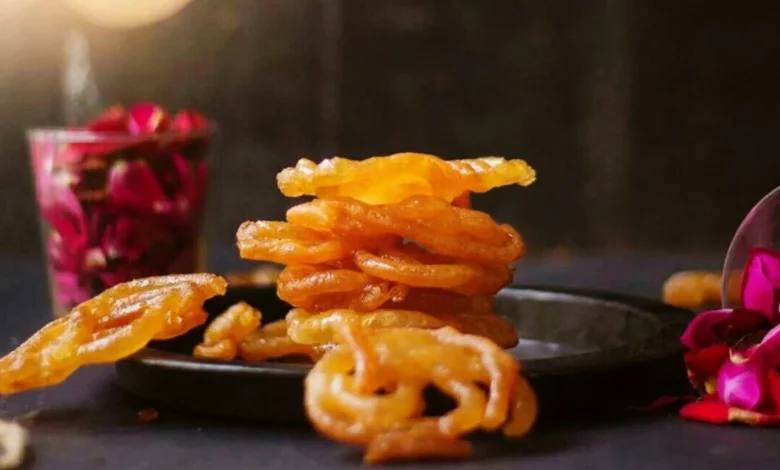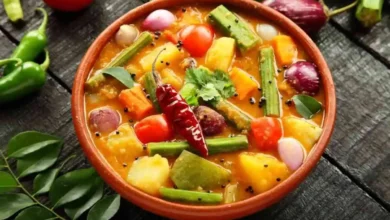#1 National Sweet of India – The Awesome ‘Jalebi’

National Sweet of India
Table of Contents
Introduction
Indians, no matter where in the world they are residing, take their food very seriously. And when it comes to sweet Indian dishes, they take their food even more seriously. One of the very famous quotes in Hindi (the National language of India) is ‘Kuch meetha ho jaaye?”, which means let’s have something sweet. Almost all Indians have a sweet tooth & India is full of traditional and delectable sweet dishes which are easy to make and use simple ingredients.
Given the diversity of this country, it’s no surprise that sweet dishes in every single region are different from the rest. Whether it is in shape, in a combination of ingredients, in texture, or in color, every sweet dish surpasses the others. The variety of sweet dishes in India will make you crave different sweet dishes in different moods. For this reason, giving the tag of the ‘National sweet of India’ is not only difficult but also contended by a lot of competitors.
In the end, however, the tag of being the national sweet of India is given to none other than the king of sweets, ‘the majestic ‘Jalebi’. Jalebi – the bright orange vortex of happiness is also known as jilapi, zalapia, and zulbia all over the country. The crispy crunchy hot spiral exterior melts as you put it in your mouth into a soggy sweet delicious mess. The versatility of jalebi is what makes it so famous and distinct from the others. You can have it with a cup of tea or dip it in a delicious bowl of rabri.
Although jalebis are loved by all, there are still reservations that come up from time to time. Other delicious and famous contenders that are loved equally by Indians are Rasgulla, Rabri, Barfi, Laddoo, Mishti Doi, Gujiya & Model, and many others.
So why is Jalebi crowned as the national sweet of India? Let’s find out.
- Versatility
Jalebis go with everything. Have it with a cup of tea, with a bowl of rabri, with your lunch/dinner, or as an evening snack. Any time of the day can be ‘Jalebi time’.
- Available Everywhere
Be it in the roadside stalls, in posh restaurants, local sweet shops, or at any Indian household, Jalebis are ubiquitous.
- Indians Occasions are incomplete without Jalebi
Any occasion is incomplete without Jalebi. Such is the tradition and culture in India.
- Can cure Headaches
In some parts of India, Jalebis are taken with warm haldi milk to cure headaches and cold. Jalebis made of pure desi ghee can also cure migraines and stress-related issues.
National Sweet of India
The History of Jalebi
Jalebi’s origins can be traced back centuries ago to the Indian subcontinent. It is believed to have its roots in West Asia and Persia, where a similar sweet dish called ‘Zolabiya’ was popular. Over time, as trade and cultural exchange flourished, Jalebi made its way to India. The recipe underwent adaptations and modifications, incorporating local ingredients and techniques, resulting in the delightful dessert we know today.
Jalebi: A Popular Indian Dessert
Cultural Significance
Jalebi holds immense cultural significance in India. It is commonly associated with celebrations, religious festivals, and joyful moments. The spiral shape of Jalebi is often seen as a representation of life’s cyclical nature, signifying good luck and prosperity. It is an integral part of weddings, birthdays, and other festive occasions, where it is served as a symbol of sweetness and auspiciousness.
Regional Variations
While Jalebi is enjoyed throughout the country, different regions have their own unique variations. In North India, the Jalebi is crispier and thicker, whereas in South India, a softer and thinner version called ‘Jilebi’ is popular. In certain regions, Jalebi is also stuffed with khoya (milk solids) or served with rabri (sweet condensed milk). These regional variations add to the diverse flavors and textures of this beloved dessert.
Festive Delight
During festivals like Diwali, Eid, and Holi, Jalebi takes center stage as a must-have sweet delicacy. It is prepared in large quantities, shared with friends and family, and exchanged as a gesture of love and goodwill. The sight and aroma of Jalebi being freshly prepared in large cauldrons at sweet shops and street food stalls add to the festive atmosphere, creating a sense of anticipation and delight.
National Sweet of India
How Jalebi is Made
The process of making Jalebi involves a few simple ingredients and a touch of culinary expertise. Let’s explore the key steps involved in creating this delectable dessert.
Ingredients
The basic ingredients used in making Jalebi include all-purpose flour, yogurt, saffron, cardamom, sugar, and oil or ghee for frying. These ingredients come together to form a batter that is left to ferment overnight, adding a tangy flavor to the final product.
Preparation Process
To make Jalebi, the batter is poured into a cloth or plastic squeeze bottle with a narrow nozzle. The cook skillfully drizzles the batter into hot oil or ghee in a circular motion, creating intricate spirals. The Jalebis are then fried until golden and crispy.
Cooking Techniques
The art of making perfect Jalebis requires precision and expertise. The cook must maintain the right temperature of the oil or ghee and control the flow of the batter to create uniform spirals. It is a skill that comes with practice and experience, resulting in Jalebis that are crispy on the outside and soft on the inside.
The Taste and Texture of Jalebi
Jalebi delights the senses with its contrasting textures and flavors. The outer layer is crisp and golden, providing a satisfying crunch, while the inner part is soaked in the sugar syrup, offering a burst of sweetness. The syrup imparts a subtle floral aroma, complementing the slight tanginess of the fermented batter. The combination of textures and flavors makes Jalebi a truly indulgent experience.
Serving and Enjoying Jalebi
Jalebi is typically served hot, right after it is taken out of the frying pan. The piping hot Jalebis are often paired with a creamy, chilled accompaniment like rabri, which balances the sweetness and adds a luscious element to the dessert. Jalebi can also be enjoyed at room temperature, and it is commonly found at sweet shops and street food stalls across India.
National Sweet of India
Health Benefits of Jalebi
While Jalebi is undoubtedly a sweet indulgence, it does offer some potential health benefits when consumed in moderation. The fermentation process in the batter increases its nutritional value and aids digestion. Jalebi also contains trace amounts of vitamins and minerals, such as iron and calcium. However, it is important to remember that excessive consumption of Jalebi can contribute to weight gain and other health issues, so moderation is key.
Jalebi and Festivals
Jalebi holds a special place during Indian festivals. For example, during Diwali, the festival of lights, Jalebi is considered auspicious and is often prepared as an offering to deities. The presence of Jalebi on festive occasions signifies abundance, joy, and celebration.
Jalebi Around the World
While Jalebi is deeply rooted in Indian culture, its popularity has transcended borders. Indian diaspora and food enthusiasts worldwide have embraced this delightful dessert. It can be found in Indian restaurants, sweet shops, and food festivals across the globe, making it a global ambassador of Indian sweets.
Jalebi: A Global Sweet
Jalebi’s appeal lies in its versatility and ability to adapt to different culinary traditions. Chefs and home cooks around the world have experimented with Jalebi, infusing it with local flavors and serving it in innovative ways. Its unique combination of crispy, sweet, and syrupy textures makes it a universally loved dessert.
Popular Jalebi Variations
Jalebi’s popularity has inspired several creative adaptations. Some variations include stuffed Jalebi filled with dry fruits or flavored creams, chocolate-dipped Jalebi, and Jalebi served with ice cream. These variations cater to diverse palates and provide exciting twists on the classic dessert.
National Sweet of India
Jalebi in Pop Culture
Jalebi has also found its way into pop culture, making appearances in movies, songs, and literature. Its visual appeal and association with joy and celebration have made it a popular symbol of Indian culture and hospitality. Jalebi’s presence in pop culture further solidifies its status as a national sweet of India.
Jalebi: A Sweet Memory
For many Indians, Jalebi holds nostalgic memories of childhood, family gatherings, and street food adventures. The aroma of freshly fried Jalebi triggers a sense of comfort and happiness, reminding people of simpler times and cherished moments spent with loved ones.
Conclusion
Jalebi, the #1 national sweet of India, is a culinary treasure that embodies the essence of Indian culture and tradition. Its rich history, cultural significance, and mouthwatering flavors have made it an integral part of Indian cuisine. Whether enjoyed during festive occasions, as a street food delight, or as a sweet treat at home, Jalebi continues to captivate hearts and palates around the world.
FAQs
- Is Jalebi the official national sweet of India? No, there is no official declaration of Jalebi as the national sweet of India. However, it is widely regarded as one of the most iconic and beloved sweet treats in the country.
- What are some other popular Indian sweets? India boasts a wide array of delightful sweets. Some popular ones include Gulab Jamun, Rasgulla, Barfi, Laddu, and Rasmalai.
- Can Jalebi be made without dairy? Yes, Jalebi can be prepared without dairy by using alternative ingredients like plant-based milk or yogurt substitutes.
- Is Jalebi suitable for vegetarians? Yes, Jalebi is typically prepared using vegetarian ingredients and is suitable for vegetarians.
- Can I make Jalebi at home without a squeeze bottle? Yes, if you don’t have a squeeze bottle, you can use a piping bag or even a ziplock bag with a small hole cut at one corner as a makeshift alternative.
Related Articles
Indian Food – A Comprehensive guide
Indian Cuisine – An Aromatic Speciality
Indian Restaurants – Where and What To Eat
5 Popular Vegetarian Indian Dishes
Top Indian Restaurant – 5 of the best in USA
5 Appetizing and Best South Indian Dishes








